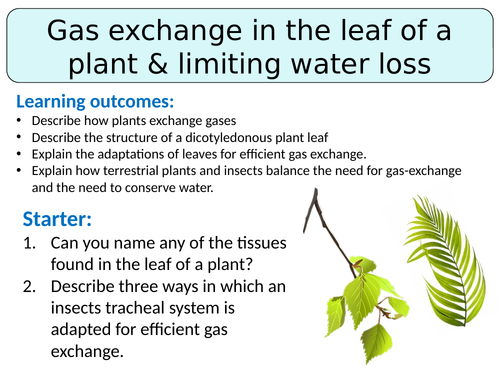

This lesson is designed for the NEW AQA AS-level Biology course, particularly the ‘Organisms & their Environment’ module.
For more lessons designed to meet specification points for the NEW AQA A-level Biology course please visit my shop: https://www.tes.com/teaching-resources/shop/SWiftScience
A-Level lesson format: I teach in more of a lecture style compared to GCSE. In the majority of my A-level lessons the beginning portion of the lesson is mainly teacher-led, where students are expected to take notes onto a handout/in their books. This is then mixed in with student-led activities, as well as questions and exam prep.
You will find some of my slides have blank spaces for you to add more detail/descriptions/explanations. If you look at the ‘Notes’ section underneath each of these slides, you will find additional content which you can add in as you teach!
This lesson in the gas exchange in the leaf of a plant and limiting water loss begins with a starter discussion to remind students of the tissues found in leaves and the tracheal system in insects.
Students will then be asked to think about the relationship between plant an animal cells and respiration of the two respectively. They should also consider when photosynthesis is taking place, and when it is not.
The first task of this lesson is a diagram worksheet to label the structures of a leaf cell. Answers are on the following slide for self-assessment, followed by a light micrograph of leaf structure.
The next task is to consider leaf adaptations for photosynthesis and identify the purpose of the adaptation (to absorb light, for gas exchange, reduce water loss, or transport). Answers follow for self-assessment.
Students are then introduced to the stomata. They should make notes on the structure when the guard cells are swollen or shrunken. The next task is to answer three summary questions, sample answers are available on the following slide for self-assessment.
The problem for all terrestrial organisms is water evaporation from the surface of their bodies. Students are asked to remember the various ways in which insects limit water loss before they are introduced to plant adaptations. Xerophytes are introduced as an example, including cacti and marram grass.
Students will then complete a table using information cards about xerophytic adaptation, and four summary questions. Answers for both follow, for self-assessment.
The final task is to complete an exam style question to consolidate their learning and self-assess to the sample mark scheme.
The plenary is to write three sentences to summarise what they have learnt this lesson!
All resources are included. Thanks for looking, if you have any questions please let me know in the comments section and any feedback would be appreciated :)
Something went wrong, please try again later.
Really useful resource, with detailed information and appropriate student tasks
Report this resourceto let us know if it violates our terms and conditions.
Our customer service team will review your report and will be in touch.